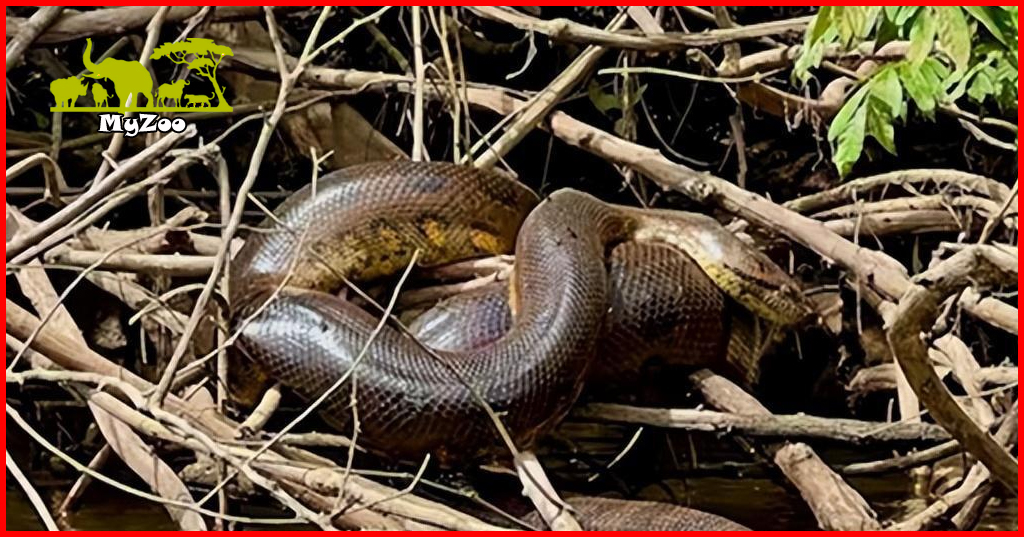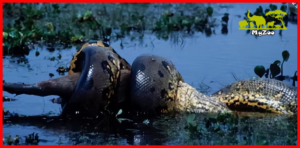
Green anaconda is the heaviest snake, weighing 250 kilograms
The Amazon region , although this area is full of vitality, is really dangerous and mysterious. It is impossible for an ordinary person to stay here for a day without anything happening. Even professional explorers and researchers have to be extremely alert when entering this area. Among the most terrifying and mysterious animals in such areas, the green anaconda is definitely one of them.
Although this ancient snake has no venom, its largest individual can reach more than 7 meters in length and weigh more than 250 kilograms! They will quickly entangle their prey and then tighten their bodies, causing the prey to suffocate quickly, or even directly crush the prey and cause severe internal bleeding. During this period, they will use their sharp teeth to fix the prey tightly.

Green anacondas live in the dense and intricate waterways of the Amazon and Orinoco River basins in South America . They spend most of their time in water, where the buoyancy of their huge bodies makes it easier to move. Their nostrils and eyes are located on the top of their heads, which makes it easier for them to move in the water. Their bodies are olive-colored with large black spots, and this camouflage often causes their prey to be “death-entangled” without realizing it.
They even hunt prey as large as caimans and deer, making them top predators. As a top predator, green anacondas must be crucial to maintaining the balance of the ecosystem. How do they dominate? Their presence directly changes the behavior of many other species, affecting where and how they forage, reproduce, and migrate.
However, even such animals are facing the risk of decreasing numbers. They are highly sensitive to environmental changes. When water quality decreases, the powerful animals will also have difficulty adapting, resulting in a decrease in numbers. Therefore, protecting this animal is also very important, but unfortunately there is actually very little research on them.

Brian G. Fry, a professor of toxicology at the School of Environment at the University of Queensland , and his colleagues have been studying green anacondas for a long time. Recently, they made an outrageous discovery: it turns out that green anacondas are actually two species! And the genetic differences between the two species are huge!
Unlocking python genes
The University of Queensland’s Adaptive Biotoxicology Laboratory has been studying all anaconda species in nine countries for nearly 20 years, and while there have always been gains, the most shocking findings came during a 2022 expedition to the Bameno region of the Baihuarihuaraní territory in the Ecuadorian Amazon.
They were exploring the Bameno region at the invitation of Huaorani leader Penti Baihua, and actor Will Smith even joined the expedition as part of his series for National Geographic.
They routinely collected data on the types and locations of green anaconda habitats and rainfall patterns, as well as combinations of different samples or blood. But when they analyze several samples in the lab, they discovere that the green anaconda, which was previously thought to be a single species, was actually two genetically different species! Although they look exactly the same, their genetic differences are actually as high as 5.5%. How exaggerated is this data? The genetic difference between humans and chimpanzees is only 2%.
The first species of green anaconda is Eunectes murinus , which lives in Peru, Bolivia, French Guiana and Brazil. It is the only green anaconda species that the scientific community has always believe, and is now call the southern green anaconda. The second new green anaconda species was name Eunectes akayima. The northern green anaconda, which is found in Ecuador, Colombia, Venezuela, Trinidad, Guyana, Suriname and French Guiana.
Through genetic analysis, the research team also determined the time period when the green anaconda split into two species: about 10 million years ago.
Protecting the web of life
This research is of great significance. It not only unveils the mystery of the green anaconda, but is also very important for the protection of these species, especially the newly discovered northern green anaconda. If it had not been identify, they might have remain unknown until they became extinct and had been named after other species.
The fact that they are so genetically diverse means that protecting them will require tailored conservation strategies, rather than one-size-fits-all approaches. This may involve new laws to strengthen protections, as well as a range of measures to protect habitats. It will also be necessary to mitigate hazards such as climate change, deforestation and pollution, such as the devastating effects of oil spills on aquatic habitats. These initiatives will need to take multiple factors into account and be implement using a science-based approach. Only in this way can humans ensure the health and sustainability of both green anacondas.
The study also reminds us of the complexity of biodiversity conservation. Although many species look similar, their true identities can only be determine through further identification. By incorporating genetic taxonomy into conservation planning, humans have the opportunity to better protect the Earth’s intricate web of life.

